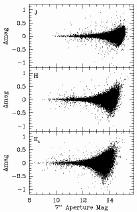
The Level 1 specification for sensitivity to extended sources are 15.0, 14.2, and 13.5 mag at J, H, and Ks respectively. 2MASS clearly exceeds this specification at J, but is borderline at H and Ks.
This specification is intended as a measure of the repeatability of flux measurements to better than 10% (0.109 mag) at the stated magnitude limits. (This does not include calibration variations which are covered by the uniformity specification.) The meaning of a flux measurement for an extended source is not as straightforward as for a point source, since there are so many different ways of measuring the magnitude (and no such thing as a "total" magnitude can be reliably measured at any wavelength). A fixed aperture test gives a good measure of the actual photometric repeatability, but a more commonly-used measure is the flux within an ellipse fit to an isophotal level. This latter method is more challenging, since uncertainties in the ellipse fitting to a faint isophote (20 mag/arcsec2 at Ks) introduce additional sources of uncertainty.
We can use the duplicate measurements of sources in the overlaps between scans to test the repeatability of the magnitudes. This test may overestimate the uncertainties because at least one of the measurements is made close to the edge of the frame. This means there is greater uncertainty in the background subtraction, and the outer parts of larger galaxies may be cut off. Figure 1 show the magnitude differences (duplicate mag - catalog mag) as a function of the catalog magnitude. The differences shown here are all for measurements with overlapping scans on the same night to avoid differences due to varying calibration solutions.

|
| Figure 1 |
To determine how well the magnitudes met the Level 1 specification, we look at the galaxies within 0.1 mag of the magnitude limit, and divide the resulting standard deviation by 21/2 (because we are considering two independent measurements). There are typically 1500-2000 pairs of sources meeting these requirements, yielding the following estimates for the magnitude uncertainties at the magnitude limits:
| Ks-band 20 mag arcsec-2 | 7´´ circular | isophotal magnitude | aperture magnitude | Mag Limit | uncertainty | uncertainty | J = 15.0 | 0.092 | 0.076 | H = 14.2 | 0.114 | 0.115 | Ks = 13.5 | 0.131 | 0.120 |
[Modified 2000 Sep 11 by S. Van Dyk.]